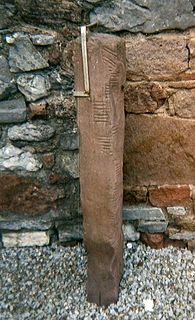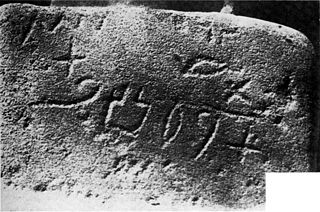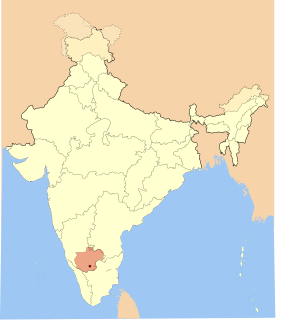
Ashoka, also known as Ashoka the Great, was an Indian emperor of the Maurya Dynasty, who ruled almost all of the Indian subcontinent from c. 268 to 232 BCE. The grandson of the founder of the Maurya Dynasty, Chandragupta Maurya, Ashoka promoted the spread of Buddhism across ancient Asia. Considered by many to be one of India's greatest emperors, Ashoka expanded Chandragupta's empire to reign over a realm stretching from present-day Afghanistan in the west to Bangladesh in the east. It covered the entire Indian subcontinent except for parts of present-day Tamil Nadu, Karnataka and Kerala. The empire's capital was Pataliputra, with provincial capitals at Taxila and Ujjain.

The Behistun Inscription is a multilingual inscription and large rock relief on a cliff at Mount Behistun in the Kermanshah Province of Iran, near the city of Kermanshah in western Iran, established by Darius the Great. It was crucial to the decipherment of cuneiform script as the inscription includes three versions of the same text, written in three different cuneiform script languages: Old Persian, Elamite, and Babylonian. The inscription is to cuneiform what the Rosetta Stone is to Egyptian hieroglyphs: the document most crucial in the decipherment of a previously lost script.

The Old Turkic script is the alphabet used by the Göktürks and other early Turkic khanates during the 8th to 10th centuries to record the Old Turkic language.

The Rosetta Stone is a granodiorite stele discovered in 1799 which is inscribed with three versions of a decree issued in Memphis, Egypt in 196 BC during the Ptolemaic dynasty on behalf of King Ptolemy V Epiphanes. The top and middle texts are in Ancient Egyptian using hieroglyphic and Demotic scripts respectively, while the bottom is in Ancient Greek. The decree has only minor differences among the three versions, so the Rosetta Stone became key to deciphering Egyptian hieroglyphs, thereby opening a window into ancient Egyptian history.

Kannada is a Dravidian language spoken predominantly by people of Karnataka in Southwestern India and by linguistic minorities in the states of Maharashtra, Andhra Pradesh, Tamil Nadu, Telangana, Kerala and Goa and also by Carnatican expats abroad. The language has roughly 44 million native speakers, who are called Kannadigas. Kannada is also spoken as a second and third language by over 12.9 million non-Kannada speakers in Karnataka, which adds up to 56.9 million speakers. It is one of the scheduled languages of India and the official and administrative language of the state of Karnataka. Kannada was the court language of some of the most powerful empires of South and Central India, such as the Chalukya dynasty, the Rashtrakuta dynasty, the Vijayanagara Empire and the Hoysala Empire.

Brahmi is the modern name for a writing system of ancient India. The Brahmi writing system, or script, appeared as a fully developed universal one in South Asia in the third century BCE, and is a forerunner of all writing systems that have found use in South Asia with the exception of the Indus script of the third millennium BCE, the Kharosthi script, which originated in what today is northwestern Pakistan in the fourth or possibly fifth century BCE, the Perso-Arabic Scripts of the medieval period, and the Latin scripts of the modern period. Its descendants, the Brahmic scripts, continue to be in use today not only in South Asia, but also Southeast Asia. Brahmi is an abugida which uses a system of diacritical marks to associate vowels with consonant symbols.

The Corpus Inscriptionum Latinarum (CIL) is a comprehensive collection of ancient Latin inscriptions. It forms an authoritative source for documenting the surviving epigraphy of classical antiquity. Public and personal inscriptions throw light on all aspects of Roman life and history. The Corpus continues to be updated in new editions and supplements.

Cuneiform was one of the earliest systems of writing, invented by Sumerians in ancient Mesopotamia. It is distinguished by its wedge-shaped marks on clay tablets, made by means of a blunt reed for a stylus. The term cuneiform comes from cuneus, Latin for "wedge".

Epigraphy, "inscription", is the study of inscriptions, or epigraphs, as writing; it is the science of identifying graphemes, clarifying their meanings, classifying their uses according to dates and cultural contexts, and drawing conclusions about the writing and the writers. Specifically excluded from epigraphy are the historical significance of an epigraph as a document and the artistic value of a literary composition.

Ogham is an Early Medieval alphabet used primarily to write the early Irish language, and later the Old Irish language. There are roughly 400 surviving orthodox inscriptions on stone monuments throughout Ireland and western Britain; the bulk of which are in southern Munster. The largest number outside Ireland are in Pembrokeshire, Wales.

Runes are the letters in a set of related alphabets known as runic alphabets, which were used to write various Germanic languages before the adoption of the Latin alphabet and for specialised purposes thereafter. The Scandinavian variants are also known as futhark or fuþark ; the Anglo-Saxon variant is futhorc or fuþorc.

The Edicts of Ashoka are a collection of more than thirty inscriptions on the pillars, as well as boulders and cave walls, attributed to Emperor Ashoka of the Mauryan Empire who reigned from 268 BCE to 232 BCE. Ashoka used the expression Dhaṃma Lipi to describe his own Edicts. These inscriptions were dispersed throughout the areas of modern-day Bangladesh, India, Nepal, Afghanistan and Pakistan, and provide the first tangible evidence of Buddhism. The edicts describe in detail Ashoka's view about dhamma, an earnest attempt to solve some of the problems that a complex society faced. According to the edicts, the extent of Buddhist proselytism during this period reached as far as the Mediterranean, and many Buddhist monuments were created.

The Kadambas were an ancient royal family of Karnataka, India, that ruled northern Karnataka and the Konkan from Banavasi in present-day Uttara Kannada district. The kingdom was founded by Mayurasharma in c. 345 which at later times showed the potential of developing into imperial proportions, an indication to which is provided by the titles and epithets assumed by its rulers and the marital relations they kept with other kingdoms and empires, such as the Vakatakas and Guptas of northern India. Mayurasharma defeated the armies of the Pallavas of Kanchi possibly with the help of some native tribes and claimed sovereignty. The Kadamba power reached its peak during the rule of Kakusthavarma.

The Elder Futhark, Elder Fuþark, Older Futhark, Old Futhark or Germanic Futhark is the oldest form of the runic alphabets. It was a writing system used by Germanic tribes for Northwest Germanic dialects in the Migration Period, the dates of which are debated among scholars. Runic inscriptions are found on artifacts, including jewelry, amulets, plateware, tools, weapons, and, famously, runestones, from the 2nd to the 8th centuries.

The Satavahanas, Sādavāhana or Sātavāhana, IAST: Sātavāhana), also referred to as the Andhras in the Puranas, were an ancient Indian dynasty based in the Deccan region. Most modern scholars believe that the Satavahana rule began in the late second century BCE and lasted until the early third century CE, although some assign the beginning of their rule to as early as the 3rd century BCE based on the Puranas, but uncorroborated by archaeological evidence. The Satavahana kingdom mainly comprised the present-day Telangana, Andhra Pradesh and Maharashtra. At different times, their rule extended to parts of modern Gujarat, Madhya Pradesh, and Karnataka. The dynasty had different capital cities at different times, including Koti Lingala Jagtial District Telangana, Pratishthana (Paithan) and Amaravati (Dharanikota).
Old Turkic is the earliest attested form of Turkic, found in Göktürk and Uyghur inscriptions dating from about the 7th century AD to the 13th century. It is the oldest attested member of the Orkhon branch of Turkic, which is extant in the modern Western Yugur language. However, it is not the ancestor of the language now called Uighur; the contemporaneous ancestor of Uighur to the west is called Middle Turkic, later Chagatai or Turki.

Proto-Sinaitic, also referred to as Sinaitic, and Proto-Canaanite, is a Middle Bronze Age script attested in a small corpus of inscriptions found at Serabit el-Khadim in the Sinai Peninsula, Egypt, considered the earliest trace of alphabetic writing, and the common ancestor of the Ancient South Arabian script and Phoenician alphabet.
Pulakeshin II was the most famous ruler of the Chalukya dynasty of Vatapi. During his reign, the Chalukya kingdom expanded to cover most of the Deccan region in peninsular India.

Western Ganga was an important ruling dynasty of ancient Karnataka in India which lasted from about 350 to 1000 CE. They are known as 'Western Gangas' to distinguish them from the Eastern Gangas who in later centuries ruled over Kalinga. The general belief is that the Western Gangas began their rule during a time when multiple native clans asserted their freedom due to the weakening of the Pallava empire in South India, a geo-political event sometimes attributed to the southern conquests of Samudra Gupta. The Western Ganga sovereignty lasted from about 350 to 550 CE, initially ruling from Kolar and later, moving their capital to Talakadu on the banks of the Kaveri River in modern Mysore district.

Halmidi is a small village in the Hassan district of Karnataka state, India, near the temple town of Belur. Halmidi is best known as the place where the oldest known inscription exclusively in Kannada language, the Halmidi inscription, was discovered. Anterior to this, many inscriptions with Kannada words have been discovered, such as Brahmagiri edict of 230 BCE of Emperor Ashoka. However, this is the first full length inscription in Kannada. This inscription is generally known as the Halmidi inscription and consists of sixteen lines carved on a sandstone slab. It has been dated to 450 CE and demonstrates that Kannada was used as a language of administration at that time. The inscription is in primitive Kannada with distinctive characteristics attributed to those of Proto-Kannada and uses Kannada script similar to Brahmi characters.
















